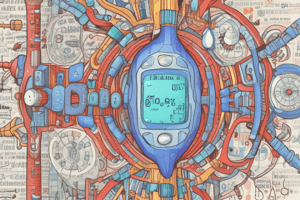Podcast
Questions and Answers
Why is it important for healthcare professionals to be aware of the plasma glucose level in individuals with hyperglycemic symptoms or crisis?
Why is it important for healthcare professionals to be aware of the plasma glucose level in individuals with hyperglycemic symptoms or crisis?
- To diagnose prediabetes
- To determine the chronicity of hyperglycemia using FPG
- To confirm that the symptoms are due to diabetes and inform treatment decisions (correct)
- To avoid the need for further A1C testing
In a non-pregnant individual, why is FPG or A1C generally preferred over the 2-hour PG test for routine diabetes screening?
In a non-pregnant individual, why is FPG or A1C generally preferred over the 2-hour PG test for routine diabetes screening?
- They're easier to administer (correct)
- They are less affected by daily variations in glucose levels.
- They provide a more accurate measure of glucose metabolism.
- They are better at detecting prediabetes.
What is a significant, yet often overlooked, concern in glucose testing that can lead to falsely low glucose concentrations?
What is a significant, yet often overlooked, concern in glucose testing that can lead to falsely low glucose concentrations?
- The patient's fasting state
- Diurnal variation of glucose
- Glycolysis in improperly handled samples (correct)
- Recent physical activity before the test
A person preparing for an OGTT should follow which dietary guideline in the days leading up to the test?
A person preparing for an OGTT should follow which dietary guideline in the days leading up to the test?
According to the referenced text, what actions should be taken if an individual has discordant results from two different diabetes tests?
According to the referenced text, what actions should be taken if an individual has discordant results from two different diabetes tests?
In which conditions is A1C not a reliable test for diagnosing diabetes and glucose criteria should be used instead?
In which conditions is A1C not a reliable test for diagnosing diabetes and glucose criteria should be used instead?
What implications arise from the finding that African American individuals may have slightly higher A1C levels independent of glucose levels?
What implications arise from the finding that African American individuals may have slightly higher A1C levels independent of glucose levels?
What actions are recommended if the A1C test results are inconsistent with glucose values?
What actions are recommended if the A1C test results are inconsistent with glucose values?
What is the recommendation when classifying individuals with hyperglycemia to facilitate personalized management?
What is the recommendation when classifying individuals with hyperglycemia to facilitate personalized management?
What clinical characteristics are most useful in determining type 1 diabetes?
What clinical characteristics are most useful in determining type 1 diabetes?
What approach is helpful for distinguishing between types of diabetes?
What approach is helpful for distinguishing between types of diabetes?
For individuals with diabetes, what strategy should be incorporated into diabetes screening to prevent CAD and rapidly progress their treatment?
For individuals with diabetes, what strategy should be incorporated into diabetes screening to prevent CAD and rapidly progress their treatment?
What is a potential action if LADA is identified?
What is a potential action if LADA is identified?
How can diagnostic accuracy be improved when screening a population with LADA?
How can diagnostic accuracy be improved when screening a population with LADA?
What benefits are associated to monitoring for Type 1 Diabetes before the start of ketoacidosis?
What benefits are associated to monitoring for Type 1 Diabetes before the start of ketoacidosis?
What autoantibodies show that an individual has a higher risk of developing multiple islet autoimmunity?
What autoantibodies show that an individual has a higher risk of developing multiple islet autoimmunity?
When is testing of islet autoantibodies recommended to screen for pre-symptomatic Type 1 Diabetes?
When is testing of islet autoantibodies recommended to screen for pre-symptomatic Type 1 Diabetes?
What role do support groups play in diabetes treatment/diagnosis?
What role do support groups play in diabetes treatment/diagnosis?
When should risk-based screening for pre-diabetes be considered in children and adolescents?
When should risk-based screening for pre-diabetes be considered in children and adolescents?
The presence of prediabetes should motivate evaluation of:
The presence of prediabetes should motivate evaluation of:
Which of the following actions is suggested for all people?
Which of the following actions is suggested for all people?
If a patient tests negative for both, should you assume they're in the clear?
If a patient tests negative for both, should you assume they're in the clear?
What role can the dentist play in prevention?
What role can the dentist play in prevention?
Post-transplant, what should be done on all patients?
Post-transplant, what should be done on all patients?
How can you prevent type 2, according to the text?
How can you prevent type 2, according to the text?
Flashcards
Diabetes Mellitus
Diabetes Mellitus
A group of metabolic disorders where glucose is underutilized and overproduced, leading to hyperglycemia.
Diagnosing Diabetes
Diagnosing Diabetes
Demonstrating elevated glucose concentrations in venous plasma or increased A1C in the blood.
Clinical Categories of Diabetes
Clinical Categories of Diabetes
Type 1, Type 2, Gestational diabetes mellitus, and specific types due to other causes.
Plasma Glucose Tests
Plasma Glucose Tests
Signup and view all the flashcards
Diabetes Diagnostic Criteria
Diabetes Diagnostic Criteria
Signup and view all the flashcards
Confirming Diabetes Diagnosis
Confirming Diabetes Diagnosis
Signup and view all the flashcards
FPG vs. 2-h PG
FPG vs. 2-h PG
Signup and view all the flashcards
A1C Pre-diabetes Range
A1C Pre-diabetes Range
Signup and view all the flashcards
FPG Pre-diabetes Range
FPG Pre-diabetes Range
Signup and view all the flashcards
2-h PG Pre-diabetes Range
2-h PG Pre-diabetes Range
Signup and view all the flashcards
A1C Test
A1C Test
Signup and view all the flashcards
Glucose Test Cost
Glucose Test Cost
Signup and view all the flashcards
A1C
A1C
Signup and view all the flashcards
Glucose Test Sample Stability
Glucose Test Sample Stability
Signup and view all the flashcards
Factors Affecting Glucose Levels
Factors Affecting Glucose Levels
Signup and view all the flashcards
A1C
A1C
Signup and view all the flashcards
Effect on A1C Testing
Effect on A1C Testing
Signup and view all the flashcards
Discordant Results
Discordant Results
Signup and view all the flashcards
Classify Individuals with Hyperglycemia
Classify Individuals with Hyperglycemia
Signup and view all the flashcards
Diabetes Categories
Diabetes Categories
Signup and view all the flashcards
Type 1 Diabetes Cause
Type 1 Diabetes Cause
Signup and view all the flashcards
Autoantibodies
Autoantibodies
Signup and view all the flashcards
Pre-stage 3 diabetes frequency
Pre-stage 3 diabetes frequency
Signup and view all the flashcards
Testing for prediabetes
Testing for prediabetes
Signup and view all the flashcards
Prediabetes Intervention
Prediabetes Intervention
Signup and view all the flashcards
Study Notes
Diabetes Diagnosis and Classification: Standards of Care in Diabetes - 2025
- American Diabetes Association (ADA) provides current clinical practice recommendations via Standards of Care
- Components of diabetes care, general treatment objectives/guidelines, and tools to assess care quality are given
- An interprofessional expert committee updates standards annually or more often if necessary
- Readers wanting to comment on the Standards of Care can do so through professional.diabetes.org/SOC
Diabetes Mellitus Overview
- A group of metabolic disorders where glucose is underutilized, and produced in excess due to inadequate gluconeogenesis/glycogenolysis
- Hyperglycemia occurs as a result
- Diagnosis involves demonstrating elevated glucose levels in venous plasma or increased A1C in blood
Diabetes Classification
- Includes type 1, type 2, gestational diabetes, and other specific types from causes such as monogenic diabetes, exocrine pancreatic disorders and high-risk meds
- Diagnostic tests encompass A1C or plasma glucose criteria, with plasma glucose including FPG, 2-h PG level during 75-g OGTT, or random glucose with hyperglycemic symptoms/crisis
- Diagnosis needs confirmatory tests unless there is obvious hyperglycemia like a hyperglycemic crisis
Diagnostic Criteria for Diabetes
- A1C of 6.5% (48 mmol/mol) is diagnostic if NGSP-certified and DCCT assay-standardized
- FPG of 126 mg/dL (7.0 mmol/L) requires no caloric intake for 8 hours minimum
- 2-h PG level of 200 mg/dL (11.1 mmol/L) during OGTT, using WHO guidelines, requires 75-g glucose load
- Plasma glucose of 200 mg/dL (11.1 mmol/L) in individuals with classic hyperglycemic symptoms or hyperglycemic crisis, random measurement taken any time of day without regard to meal time
Considerations for Diagnosis
- Two abnormal results from different tests like A1C and FPG can confirm, or the same test at different times
- FPG (or A1C) generally preferred when screening non-pregnant people because it's easier to administer
- 2-h PG test (OGTT) diagnoses more prediabetes/diabetes than the other two tests; preferred for some conditions (cystic fibrosis-related diabetes)
- If no classic hyperglycemia symptoms, testing should be repeated to confirm
- Glucose tests are affordable and available but may have variations in glucose and require fasting/glucose control
- A mixed diet/pattern (150g carbs minimum) advised for 3 days before OGTT to avoid false positives
Prediabetes Diagnostic Criteria
- A1C 5.7-6.4% (39-47 mmol/mol)
- FPG 100 mg/dL (5.6 mmol/L) - 125 mg/dL (6.9 mmol/L) (IFG)
- 2-h PG during 75-g OGTT 140 mg/dL (7.8 mmol/l) - 199 mg/dL (11.0 mmol/l) (IGT)
- Risk increases across the board including below the lower limits, greatest at the extreme tops
Use of A1C in Diabetes Detection and Diagnosis
- A1C testing should use NGSP-certified method as per the name
- Trazable to Diabetes Control and Complications Trial reference assay
- Point-of-care A1C tests for diabetes detection/diagnosis restricted to FDA-approved devices in CLIA-certified labs run by trained personnel
- Substantial discordance between blood glucose/A1C indicate test problem/interference evaluation
- For conditions with altered A1C-glycemia relationship, use plasma glucose instead
- The test measures glucose attached to hemoglobin over the life of a red blood cell up to 120 days, most heavily weighted towards recent exposure, and clinically meaningful results can be observed in less than 120 days if rapid changes in blood sugar levels occur
- Testing cannot be reliably used for an accurate diagnosis in people with anemia among others where hemoglobin is not normal
Confirming a Diagnosis of Diabetes
- Confirmation of diagnosis with 2 abnormal test results needed unless clear clinical diagnosis
Recommendation for classifying Hyperglycemia correctly
- facilitates personalized management
The Main Four Diabetes Classifications
- Type 1 Diabetes (due to autoimmune B-cell destruction, typically leading to absolute insulin deficiency)
- Type 2 Diabetes (due to progressive insulin secretion loss/inadequate amount in the context of insulin resistance)
- Specific types of diabetes (e.g., monogenic diabetes syndromes chemical-induced)
- Gestational Diabetes Mellitus - GDM (diagnosed in the 2nd/3rd trimester)
Studying That Suits You
Use AI to generate personalized quizzes and flashcards to suit your learning preferences.




